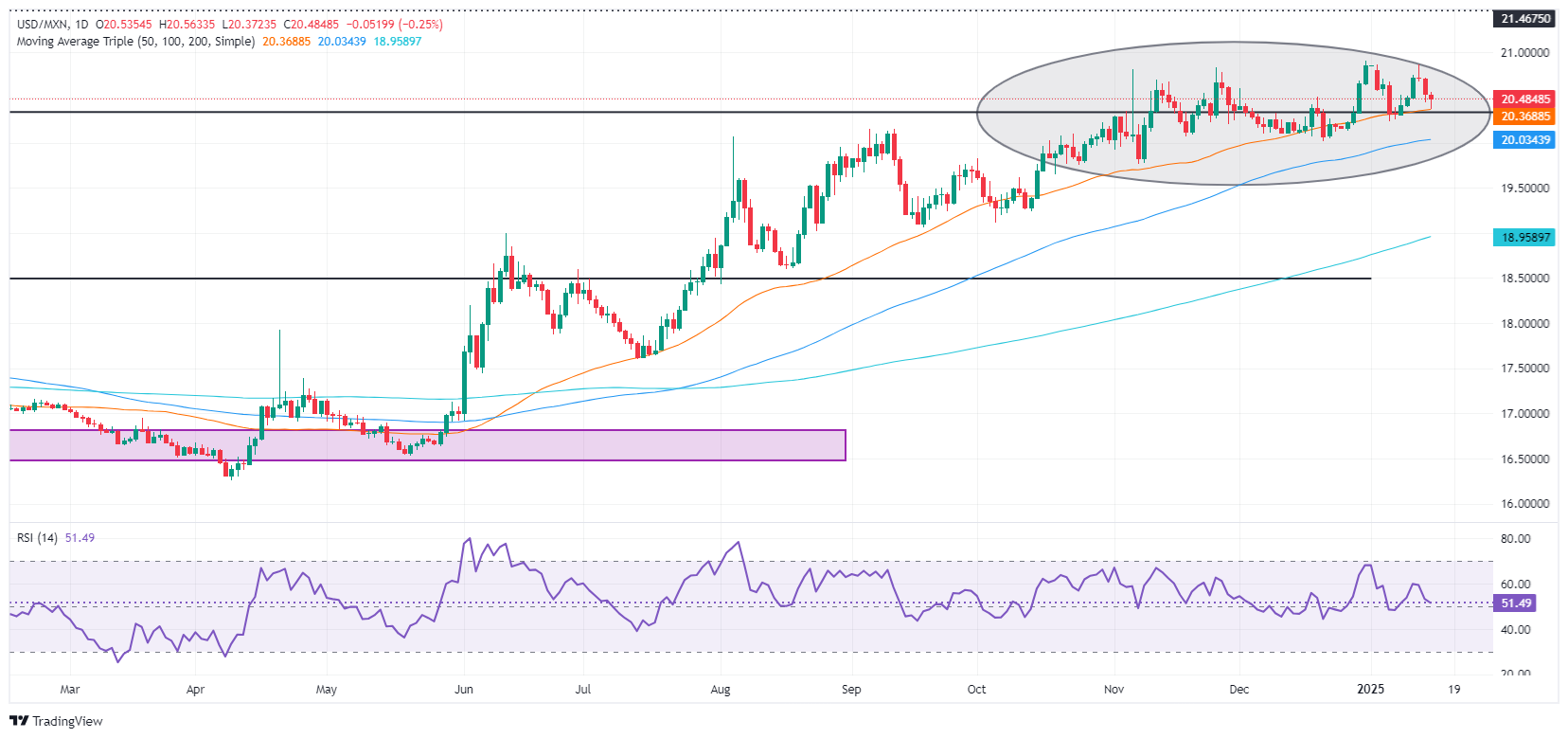Most recent article: Mexican Peso plunges to three-day low ahead of Trump’s inauguration
- The Mexican Peso maintains its upward trajectory against the Dollar, buoyed by improved Gross Fixed Investment in October.
- Mixed US inflation data, with core figures below expectations, bolsters the market view of possible continued Fed easing.
- Divergent monetary policies between Banxico and the Fed could limit the Peso’s advance, with key economic data due next week.
The Mexican Peso clings to earlier gains against the Greenback on Wednesday following the release of mixed United States (US) inflation data. Though headline inflation increased, core figures dipped compared to estimates and previous data. Therefore, the USD/MXN dropped 0.09%, trading at 20.48 at the time of writing.
The market mood remains upbeat following the release of US inflation data. Mixed figures revealed by the US Bureau of Labor Statistics (BLS) weighed in the US Dollar as traders grew confident that the Federal Reserve (Fed) might continue to ease monetary policy. Recently, Fed policymakers acknowledged they were less worried about the labor market yet showed concerns about “stickier” prices.
In Mexico, Gross Fixed Investment improved in October, according to monthly figures. However, on an annual basis, investment shrank for the second straight month.
After the data, USD/MXN continued its downtrend for the third day. However, charts suggest that the pair may face strong support before testing the crucial $20.00 figure.
In addition, the Central Bank divergence between the Bank of Mexico (Banxico) and the Federal Reserve could cap Peso’s gains. Banxico hinted it’s ready to increase the rhythm of monetary policy easing, while the Fed has opted for a gradual approach.
Mexico’s economic docket is absent this week, but next week’s inflation figures for the first fifteen days of January could set Banxico’s tone for the first meeting of the year. Investors will also eye the release of Economic Activity figures, a proxy for the Gross Domestic Product (GDP)
The US schedule will feature Retail Sales and Initial Jobless Claims data on Thursday.
Daily digest market movers: Mexican Peso benefits from weak US Dollar
- Overall, the US Dollar weakness keeps USD/MXN pressured. The US Dollar Index (DXY), which tracks the performance of the Greenback versus six other currencies, falls 0.05% to 109.12.
- The December US Consumer Price Index (CPI) increased by 2.9% YoY, in line with expectations and higher than November’s 2.7%. Core CPI rose by 3.2% YoY, slightly below the 3.3% recorded in the previous month.
- Mexico’s Gross Fixed Investment expanded by 0.1% in October from the previous month, revealed the Instituto Nacional de Estadistica Geografia e Informatica (INEGI). For the same period a year earlier, machinery, equipment and construction spending plunged 2.6%, up from a 2.9% contraction.
- Upcoming US data includes Retail Sales, which are projected to grow by 0.6% Month over Month in December, down from November’s 0.7%. Initial Jobless Claims for the week ending January 11 are expected to rise to 210K, up from 201 K.
- New York Fed President John Williams noted that the neutral interest rate is elevated due to the country’s high debt levels. While inflation has eased, Williams emphasized the Fed is monitoring potential fiscal policy changes by elected officials.
- Chicago’s Fed Austan Goolsbee was dovish. He said he still sees continued progress on inflation and added that for the last six months, PCE inflation has run close to the 2% goal. Earlier, Richmond Fed Thomas Barkin commented that inflation is approaching the 2% target and added that the labor market has stabilized.
- Minneapolis Fed President Neel Kashkari said that tariffs do not cause inflation. But tit-for-tat retaliation is more complicated.
USD/MXN technical outlook: Mexican Peso recovers as USD/MXN falls below 20.50
The USD/MXN pair is upward biased despite retreating toward the 50-day Simple Moving Average (SMA) of 20.32. Although the exotic pair is trending lower during the current week, the Relative Strength Index (RSI) suggests that buyers remain in charge.
If USD/MXN clears the 50-day SMA, this will expose the 100-day SMA at 19.99. A breach of the latter will send the pair towards the October 18 swing low of 19.64, ahead of the 19.50 figure.
Conversely, if USD/MXN rises past 20.50, the first resistance will be the year-to-date (YTD) peak of 20.90. If surpassed, the next stop would be March 8, 2022, which is a high of 21.46, ahead of 21.50, and at the 22.00 psychological level.
Fed FAQs
Monetary policy in the US is shaped by the Federal Reserve (Fed). The Fed has two mandates: to achieve price stability and foster full employment. Its primary tool to achieve these goals is by adjusting interest rates. When prices are rising too quickly and inflation is above the Fed’s 2% target, it raises interest rates, increasing borrowing costs throughout the economy. This results in a stronger US Dollar (USD) as it makes the US a more attractive place for international investors to park their money. When inflation falls below 2% or the Unemployment Rate is too high, the Fed may lower interest rates to encourage borrowing, which weighs on the Greenback.
The Federal Reserve (Fed) holds eight policy meetings a year, where the Federal Open Market Committee (FOMC) assesses economic conditions and makes monetary policy decisions. The FOMC is attended by twelve Fed officials – the seven members of the Board of Governors, the president of the Federal Reserve Bank of New York, and four of the remaining eleven regional Reserve Bank presidents, who serve one-year terms on a rotating basis.
In extreme situations, the Federal Reserve may resort to a policy named Quantitative Easing (QE). QE is the process by which the Fed substantially increases the flow of credit in a stuck financial system. It is a non-standard policy measure used during crises or when inflation is extremely low. It was the Fed’s weapon of choice during the Great Financial Crisis in 2008. It involves the Fed printing more Dollars and using them to buy high grade bonds from financial institutions. QE usually weakens the US Dollar.
Quantitative tightening (QT) is the reverse process of QE, whereby the Federal Reserve stops buying bonds from financial institutions and does not reinvest the principal from the bonds it holds maturing, to purchase new bonds. It is usually positive for the value of the US Dollar.
Information on these pages contains forward-looking statements that involve risks and uncertainties. Markets and instruments profiled on this page are for informational purposes only and should not in any way come across as a recommendation to buy or sell in these assets. You should do your own thorough research before making any investment decisions. FXStreet does not in any way guarantee that this information is free from mistakes, errors, or material misstatements. It also does not guarantee that this information is of a timely nature. Investing in Open Markets involves a great deal of risk, including the loss of all or a portion of your investment, as well as emotional distress. All risks, losses and costs associated with investing, including total loss of principal, are your responsibility. The views and opinions expressed in this article are those of the authors and do not necessarily reflect the official policy or position of FXStreet nor its advertisers. The author will not be held responsible for information that is found at the end of links posted on this page.
If not otherwise explicitly mentioned in the body of the article, at the time of writing, the author has no position in any stock mentioned in this article and no business relationship with any company mentioned. The author has not received compensation for writing this article, other than from FXStreet.
FXStreet and the author do not provide personalized recommendations. The author makes no representations as to the accuracy, completeness, or suitability of this information. FXStreet and the author will not be liable for any errors, omissions or any losses, injuries or damages arising from this information and its display or use. Errors and omissions excepted.
The author and FXStreet are not registered investment advisors and nothing in this article is intended to be investment advice.
Recommended content
Editors’ Picks

EUR/USD flirts with 1.0500 on mixed US PMI readings
The bullish momentum remains unchanged around EUR/USD on Friday as the pair keeps its trade close to the area of multi-week highs around the 1.0500 barrier in the wake of the release of mixed results from the preliminary US Manufacturing and Services PMIs for the current month.

GBP/USD challenges recent peaks near 1.2450
GBP/USD pushes harder and puts the area of recent two-week highs near 1.2450 to the test on the back of the intense sell-off in the Greenback, while the British pound also derives extra strength from earluer auspicious prints from advanced UK Manufacturing and Services PMIs.

Gold keeps the bid bias near its all-time high
Gold prices maintain the bid tone near their record top at the end of the week, helped by the intense weakness around the US Dollar, alleviating concerns surrounding Trump's tariff narrarive, and a somewhat more flexible stance towards China.

Dogelon Mars pumps more than 85%, whales dump 128 billion coins and realize a profit
Dogelon Mars (ELON) price continues its rally on Friday after rallying more than 18% this week. On-chain data shows that ELON whale wallets realized profits during the recent surge. The technical outlook suggests a rally continuation of the dog-theme meme coin, targeting double-digit gains ahead.

ECB and US Fed not yet at finish line
Capital market participants are expecting a series of interest rate cuts this year in both the Eurozone and the US, with two interest rate cuts of 25 basis points each by the US Federal Reserve and four by the European Central Bank (ECB).

Trusted Broker Reviews for Smarter Trading
VERIFIED Discover in-depth reviews of reliable brokers. Compare features like spreads, leverage, and platforms. Find the perfect fit for your trading style, from CFDs to Forex pairs like EUR/USD and Gold.
